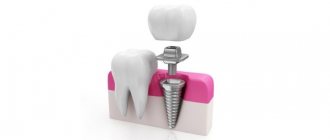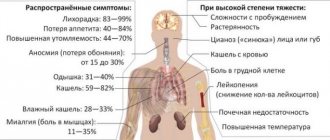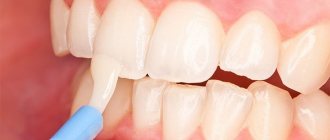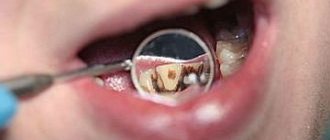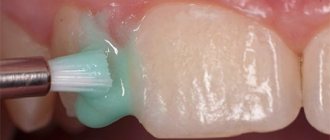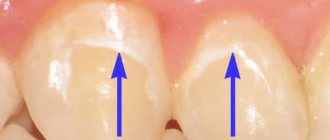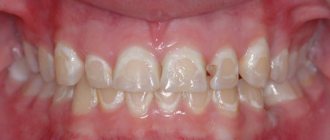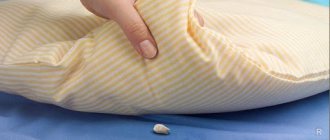Tooth enamel is the hardest tissue in the human body. Thanks to its mechanical properties, it reliably protects the pulp and dentin of the tooth from harmful bacteria and damage from chewing food. But even this fabric can be destroyed. In this case, a person needs to immediately restore tooth enamel, since weakening of the protective layer can lead to various diseases. It is necessary to know why the enamel is destroyed, what symptoms indicate the appearance of defects and, in general, whether the enamel on the teeth is restored.
Signs of damage to tooth enamel
The destruction of enamel occurs either instantly, breaking off in a whole piece, or gradually, thinning day after day. In the first case, a person begins to feel severe pain when eating immediately after mechanical damage. In addition, the chip site looks very different from the rest of the tooth.
In another case, destruction can last for years. The presence of such a process may be indicated by the occurrence of short-term pain when eating cold, hot and sour foods. Over time, the pain intensifies, as does its duration. Discomfort when chewing, which, as thinning continues, becomes painful.
The loss of shine and the enamel becoming dull in color due to the leaching of calcium and fluorine ions. When there are more of these substances than necessary, saturated white spots appear on the teeth. The appearance of dark spots and rough surfaces due to the development of caries.
If any of these symptoms occur, you should contact your dentist to determine whether the enamel on your teeth has worn off or not. When problems are confirmed, the cause of destruction is initially identified and eliminated, and only then the necessary treatment procedures are carried out.
Acute toothache
It appears very unexpectedly and is rapidly gaining strength. Pain in the teeth can be so severe that a person may lose consciousness for a while.
Severe toothache can occur when eating, while talking, while drinking a cup of coffee, when clenching your jaw, turning or tilting your head, climbing stairs, and even just while breathing. During each of these actions, the sensitive tooth will encounter irritants and react with severe pain:
- For hot food or water;
- To cold air;
- To change pressure and increase blood circulation.
In this case, toothache can be short-term, occur only in the presence of irritating factors and subside after their removal, incessant, or it can appear and disappear.
We suggest you read: How to use folk remedies to get rid of bitterness in the mouth?
In any case, toothache is a reason to immediately consult a doctor. Without delay and expectation of serious complications.
Causes of enamel destruction
Reduction in thickness and destruction of tooth enamel can occur for a number of reasons:
- Lack or excess of vitamins and microelements in the body. The main ions are calcium and fluorine, the content of which makes up 95% of the total composition.
- Teeth whitening using products that contain soda, acids or hydrogen peroxide. Such problems often arise if a person performed the procedure independently at home.
- Genetic diseases that weaken the strength of enamel (dentine dysplasia, trichodento-osseous syndrome).
- Congenital thin layer.
- Lack of or improper oral care (hard toothbrush, toothpaste without fluoride).
- Eating large amounts of fruits that are high in acids.
- Frequent consumption of nuts, seeds and other highly hard foods.
- Bad habits (biting nails or pencils, opening bottles with teeth).
- Violation of the protective properties of saliva, in which pathogenic bacteria actively multiply in the oral cavity.
- Smoking and drinking alcohol, which leads to the leaching of calcium and fluoride from hard tissues
- Drinking large amounts of carbonated drinks and sweets.
- Malocclusion.
Enamel of baby teeth
For some parents who believe that their baby's baby teeth will fall out sooner or later, restoring tooth enamel seems pointless. But this is a huge misconception. It is also very important for children to restore enamel. After all, the formation of a correct permanent bite will depend on the health of baby teeth.
For this purpose, the same means are used as for adults.
Methods for regenerating tooth enamel for minor defects
After the reason for the surface defect has been determined, the dentist decides which method is best to restore the tooth enamel. The choice is determined by the degree of damage, medical indications and the capabilities of the clinic.
Minor damage to the enamel means its tarnishing or the appearance of painful sensations when eating, due to an imbalance of calcium and fluoride ions. In this case, restoration of tooth enamel is carried out by fluoridation or remineralization and depends on the type of missing substance.
During fluoridation, the dentist applies a special varnish that contains a large amount of fluoride to the surface of damaged teeth. After the varnish dries, fluoride is gradually absorbed into the enamel over several hours, replenishing its deficiency. The procedure can be repeated several times until the balance of the missing substance is completely restored, which is determined by the appearance of the surface.
This method can only be used in a dental clinic , since contact of the active substance with the mucous membranes causes chemical burns. The fluoridation procedure can be carried out no more than once every six months, so as not to achieve the opposite effect - an excess of fluoride, which can also lead to the destruction of the enamel.
The remineralization procedure is very similar to fluoridation restoration. The only difference is in the composition of the active substances. During fluoridation, the main active component of the varnish is fluorine, and during remineralization, calcium and other minerals are used. The procedure is designed for several stages, since the method is cumulative.
Like fluoridation, remineralization should not be done more than once every six months. This recovery method can also be used at home using specially designed gels. However, self-treatment is less effective than in a dental office.
The enamel on your teeth has worn off: what to do and how to avoid it - DENTIST
Enamel covers the part of the tooth that is subject to acid attack by cariogenic bacteria, protecting the tooth from wear. This coating consists of 4–5% water and organic components (proteins), the remaining 95–96% are inorganic substances (calcium, potassium, sodium, phosphorus, etc.).
The thinning of the enamel is manifested by yellowing of the teeth
The nature of tooth enamel
Despite its hardness, enamel does not contain cells or blood vessels. It becomes brittle when the underlying tissue, called dentin, loses its elasticity. The coating wears off due to its sensitivity to acids, from mechanical stress (bruxism, intensive brushing of teeth), as well as due to insufficient cleaning of the oral cavity.
Signs of worn enamel
You can determine whether the enamel on your teeth has worn away at home; the following signs will indicate this:
- yellowed teeth (this occurs due to thinning of the enamel, through which the dentin color comes out);
- excessive sensitivity to sweet foods and drinks;
- chipped teeth;
- holes or depressions on the surface of the teeth;
- visible spots.
Why does tooth enamel wear off?
The dental coating can wear off for several reasons, and it is difficult to clearly answer why the enamel wears off. First of all, its integrity is affected by acids contained in water and food that a person consumes.
Other reasons for damage to the coating may be diseases of the gastrointestinal tract, psychological problems, as well as genetic heredity, that is, bad enamel is inherited by a person.
Acids dissolve the calcium contained in the enamel, causing erosion and wear.
Foods that contain the most acids:
Fruits and vegetables:
- oranges;
- grapefruits;
- tomatoes;
- carrot;
- apples;
- a pineapple;
- strawberry;
- kiwi;
- grape;
- honey.
Drinks and condiments:
- wine;
- vinegar;
- tea;
- coffee;
- carbonated sweet drinks;
- fruit juices.
Simple sugars:
- sucrose;
- glucose;
- fructose;
- starch in excess quantities.
Diseases and medications that increase oral acidity:
- Gastroesophageal reflux causes stomach acid to rise into the mouth, attacking the enamel.
- Eating disorders such as bulimia (recurrent vomiting) increase acid production.
- Mental disorders that cause digestive problems or poor salivation contribute to poor acid neutralization.
- Xerostomia (dry mouth), which is characterized by poor saliva production, does not protect the enamel from demineralization, since saliva contains substances that protect the tooth from negative influences.
- Genetic ailments (heredity) are also one of the reasons for the hardness of the dental coating and determine dry mouth.
- Aspirin and anti-helminth drugs.
Dental necrosis due to reflux disease
Mechanical influence factors
Mechanical factors that contribute to the weakening of enamel:
- Bruxism is teeth grinding while asleep.
- Brushing too vigorously.
- The use of aggressive toothpastes with a strong whitening effect.
- Poor oral hygiene increases the concentration of bacteria in the mouth.
Erasure of tooth enamel due to bruxism
How to prevent tooth enamel wear at home
The covering of teeth does not consist of cells, and it is not capable of regeneration. Therefore, when the enamel on the teeth is worn away, a person asks the question: “What to do?”
Damaged enamel due to very intense cleaning
You can prevent a situation where the enamel on your teeth is worn away by protecting the surface of your teeth by changing some eating habits that cause the coating to wear off. Simple tips you can use to avoid damaging your natural tooth protection:
- Drink sour and carbonated drinks through a straw to reduce the amount of time the acid comes in contact with your teeth.
- Do not brush your teeth immediately after eating food or drinks that contain large amounts of acid. Wait 30-60 minutes to allow saliva to balance the pH of your mouth so that the toothbrush is less damaging to the already acidic surface.
- Eat calcium-rich foods such as cheese, milk, and yogurt.
- Keep your mouth clean every day. Teeth should be brushed twice a day using a soft-bristled toothbrush and mouthwash.
Chronic dental trauma - worn enamel
Products that prevent enamel wear
You can prevent the erosion of tooth enamel at home using special means:
- Fluoride toothpaste makes teeth resistant to acids.
- Mouthwashes made with fluoride salts create a protective layer that counteracts acid.
- Fluoride gel protects teeth by strengthening the natural coating, prevents the development of caries and improves oral hygiene.
- Calcium and vitamin D supplements increase the hardness and strength of enamel.
- Coconut oil mineralizes teeth and helps restore enamel.
In cases where tooth enamel is in disrepair, it is necessary to seek the services of a dentist to reconstruct the surface of the tooth or remove it. At home, you can only protect the coating of your teeth from wear; you cannot cure depleted enamel.
Preparation for enamel regeneration
To prevent hypersensitivity, which will cause pain when chewing and exposure to hot and cold substances.
Children's tooth enamel is more susceptible to acids
Defects resulting from exposure to acids are observed more often in children than in adults. The natural covering of baby teeth is much more susceptible to wear, since it is less mineralized and has a softer structure than in adults.
Children's bad habits that lead to enamel wear:
- A child’s habit of thumb or pacifier sucking, which continues until the age of 4-5, negatively affects not only the enamel, but also the position of the teeth, as well as the shape of the palate.
- In children who often hold a bottle or pacifier in their mouth, the enamel peels off their teeth.
- Therefore, it is necessary to ensure that the child falls asleep on his own without a bottle containing sweet water or tea, as well as pacifiers. This is a very important rule that will prevent baby teeth from wearing out.
- Start brushing your children's teeth as soon as the first tooth appears. Even on one tooth the enamel can wear off, so you need to carefully monitor its hygiene. Choose a brush for children of the appropriate size, with soft bristles, replace it every 2-3 months, prefer toothpaste for children.
Children over 6 years of age must brush their own teeth.
Habits that contribute to enamel wear
Our teeth are exposed to constant chemical and physical attacks that can lead to undesirable effects including opacity, dark stains on the teeth, and yellowing.
Too hard foods, brushes with hard bristles, overly abrasive toothpastes, bad habits, and improper bite damage the enamel. Minimal trauma that is repeated over a long period of time can lead to its loss.
There are professions and habits that increase the wear of tooth enamel. Smokers experience wear on their side teeth and canines, while seamstresses may experience damage to their incisors as they often tear thread with their teeth. Many men have the habit of holding nails between their teeth, wearing away the enamel on their front teeth. Glassblowers and musicians who play wind instruments wear down their front teeth.
Smoker's teeth have damaged enamel
Damage to enamel cannot be repaired naturally because enamel does not contain cells.
Research in the chemical and biotechnological field presents the following options for combating worn enamel:
- At home, it is recommended to use toothpastes that contain components of hydroxyapatite particles similar to enamel dentin. Such toothpastes also contain zinc, a strong antiseptic whose activity can effectively combat the formation of bacterial plaque.
- If the enamel comes off a tooth, urgent dental intervention is necessary. This will help prevent the enamel from completely coming off.
Useful habits to help prevent enamel wear
Brush your teeth and floss every day. This simple habit will help keep your teeth and gums healthy. A clean mouth prevents the continuous influence of bacteria, which leads to enamel erosion and unsightly stains. If you cannot brush your teeth after eating, use chewing gum.
Limit your consumption of sugary foods and drinks. Their use contributes to enamel erosion. If for some reason you eat them, try to brush your teeth right away to limit the damage.
Avoid mouthwashes that contain alcohol.
A bad habit of clenching your teeth leads to wear and tear of tooth enamel. If you suffer from bruxism, alert your dentist. Bruxism leads to cracked and chipped teeth. There are other bad habits that damage teeth, such as holding objects with your teeth.
Chew gum. It promotes the production of saliva, which prevents the negative effects of acids.
Source:
The main causes of tooth wear and ways to eliminate the problem
13917
Tooth wear is a pathological process characterized by a decrease in the upper layers of the tooth crown and a decrease in the height of the elements of the dentition.
This leads to increased sensitivity, changes in the shape of the coronal part and disruption of occlusion. Increased tooth wear requires immediate treatment.
Physiology
Abrasion of hard dental tissues is diagnosed in 12% of patients. The risk group includes men, since most often they have bad habits, and their professional activities involve being in harmful conditions.
The degree of abrasion depends on the age group:
- By the age of thirty, the surface of the teeth is limited only by the enamel and does not affect the dentin, which is a normal state of the body.
- By the age of fifty, dentin damage occurs, as a result of which the molars acquire a yellowish or brown tint. This leads to painful sensations and large changes in the shape of the teeth.
- At the age of 60, there is a strong change in the front teeth, and by 70, the pathological process may affect the crown. Often the contours of a cavity are visible, which is filled with tertiary dentin.
Source: https://karkonda.ru/hirurgiya/na-zubah-sterlas-emal-chto-delat-i-kak-etogo-izbezhat.html
Methods for regenerating tooth enamel with significant damage
Significant damage to the enamel includes large chips, cracks in the tooth surface, areas of caries, and complete or almost complete destruction of the protective layer. To eliminate such damage, the following is used: enamel implantation, application of composite materials, installation of veneers.
All methods for restoring severe enamel damage are performed only in dental clinics. The choice of restoration method significantly depends on the capabilities of the clinic itself.
For example, enamel implantation is performed only by a highly trained dentist, and when using veneers, sophisticated equipment is required to fit them. Therefore, in most cases, composites are used in restoration.
Implantation
Implantation of tooth enamel is the only way to restore severe damage , in which, during the treatment process, a new section of the layer is connected at the cellular level with the old one. This is achieved by applying a special product to the tooth, which is similar in its properties to the protein amelogenin, which serves as a natural catalyst for the crystallization of the protective layer.
After applying the drug, a natural growth of the problem area occurs. Dental enamel implantation is used to treat cracks and eliminate minor caries. Treatment lasts for a month. Enamel implantation has the following advantages:
- the restored fabric is no different from the natural one, which allows it to serve throughout a person’s life;
- the procedure is painless.
The only drawback of this method is the price, which is several times higher than other restoration methods.
Use of composite materials
Restoring enamel with composite materials is used for marginal chips, scratches and gouges on the surface of teeth. Treatment is carried out with materials that are used for filling. They are applied to the damaged area in layers.
This is done to give the restored area mechanical strength comparable to natural enamel. This method of restoration is considered the cheapest option for severe damage. The disadvantages of this method are:
- short service life, which does not exceed five years;
- gradual destruction of natural enamel around the restoration site due to the release of harmful substances by composites.
Installation of veneers
For severe chips or in cases where fluoridation and remineralization do not help, a veneer is installed on the tooth - a thin ceramic plate that is attached to the front side of the molar and completely repeats its shape.
This method is excellent for restoring the appearance of molars, as the result is a healthy color and shine to the teeth. Veneers last for more than 10 years.
The disadvantages include the high price and complete destruction of the protective layer under the veneer due to the use of special adhesives during their installation.
Cost of restoring tooth enamel
It is very difficult to say how much it will cost to restore tooth enamel. Since the price may vary in different clinics. The cost also depends on the condition of the teeth and the method that will be used. Before prescribing any procedure to restore enamel, the doctor carefully examines the entire oral cavity and, if necessary, prescribes the most appropriate treatment method.
Average prices for different methods of enamel restoration are:
- The remineralization procedure costs approximately 2.5-3 thousand rubles.
- Simple fluoridation of one row of teeth costs approximately 1.3 thousand rubles.
- Deep fluoridation - approximately 260 rubles per tooth.
- Enamel implantation - 2-2.5 rubles.
- Filling - approximately 3.5 rubles.
- One veneer costs approximately 16 thousand rubles, and one lumineer costs 40-50 thousand rubles.
Recovery at home
You can restore tooth enamel at home. To do this you need:
- Use specialized toothpastes.
- Review your diet.
- Use traditional methods.
The question often arises: is tooth enamel restored when brushing your teeth? When tarnishing or minor scratches on the surface of the molars occurs, regular cleaning with pastes containing fluoride and calcium helps. The content of these substances must be at least 2 mg. In addition, you can use rinses that also contain essential minerals.
Another important condition that can help restore hard surfaces is adjusting your daily diet . If minor restoration is necessary, it is worth introducing foods rich in microelements, especially fluorine and calcium.
Folk remedies include rinsing with a solution consisting of milk and tea tree oil . In addition, they use the pulp of citrus fruits (lemon, orange, etc.).
It is important to remember that such recovery is much weaker than with procedures performed in dental clinics. Therefore, home methods should be used as a preventive measure or for minor injuries.
Restoring tooth enamel is an important procedure that must be carried out immediately at the first symptoms of problems with the protective surface of the molars. You can do it at home, however, for greater effect, you should seek qualified help from a dental clinic.
Where to start treatment
If your doctor examines your mouth and finds exposed dentin, he can help you combat the problem. You need to start treating tooth sensitivity at the dentist's office. In dentistry, there are several professional methods of saving from hyperesthesia, the essence of which is to coat the teeth with special compounds that protect the enamel and make it healthy. Here are the most common procedures:
- Exposed areas of dentin are coated with fluoride-containing varnish, which protects the hard tissue from external irritants.
- A special composite material is used to seal the exposed tooth surface.
- The mouthguard is filled with gel containing fluoride. You will need to keep the mouth guard in your mouth for about 5 minutes, during which time the fluoride will saturate your teeth and strengthen them.
Fluoridation is an important part of treatment
These procedures, performed by a professional, perfectly reduce hyperesthesia, but to prevent it, you need to continue to monitor the condition of the oral cavity. Therefore, your dentist will recommend simple steps that can reduce tooth sensitivity at home. We are talking about medicinal rinses, gels and pastes, special films, and traditional medicine.
